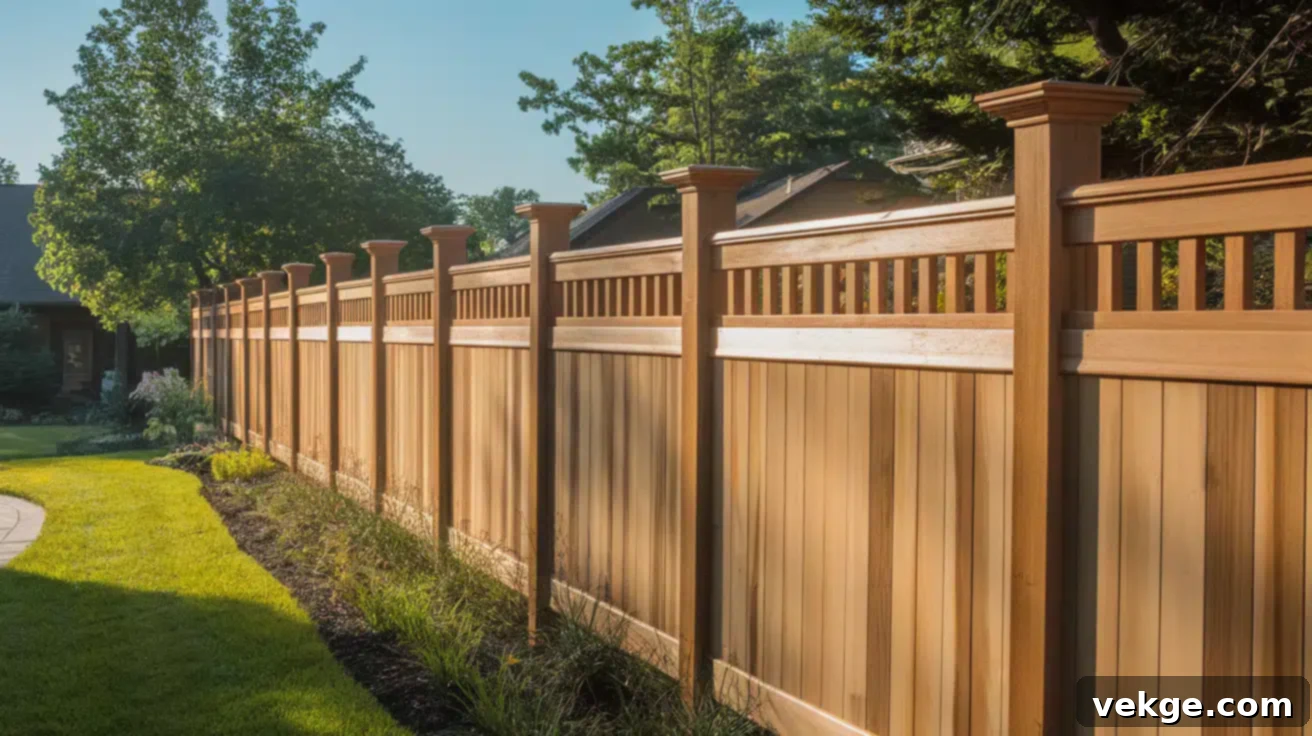The Ultimate Guide to Cap and Trim Fences: Enhance Your Home’s Style & Durability
A cap and trim fence is more than just a barrier; it’s a sophisticated design element that significantly enhances your property’s curb appeal and longevity. With its distinctive top cap and precisely fitted side trim pieces, this type of fencing adds an elegant, finished look to any yard, transforming a simple boundary into a beautiful architectural feature.
These fences are increasingly popular among homeowners because they offer a perfect blend of aesthetic charm and practical benefits. They provide superior protection against the elements, extending the fence’s lifespan, and significantly boost your property’s visual appeal and overall value. Choosing a cap and trim fence means investing in a solution that makes your home stand out while simultaneously ensuring security and privacy.
In this comprehensive guide, we’ll delve into every aspect of cap and trim fences, providing you with all the essential information needed to make an informed decision for your home. We’ll cover:
- Why these premium fences are a worthwhile investment
- The diverse types of materials and styles available
- A step-by-step guide on how to install them yourself
- Expert tips and strategies to keep them looking pristine for years
Ready to discover how a cap and trim fence can elevate your outdoor living space? Let’s get started!
What is a Cap and Trim Fence?
At its core, a cap and trim fence is a type of wooden privacy fence distinguished by its additional structural and decorative components: the “cap” and the “trim.” The cap, typically a wide board, rests horizontally along the very top of the fence panels and posts, providing a clean, continuous line. The trim boards, often narrower, run along the top and bottom edges of the fence panels, framing the pickets and creating a more polished appearance.
This design goes beyond basic functionality, offering a superior mix of style and strength that truly elevates your yard’s aesthetic. The added elements are not just for show; they play a crucial role in the fence’s structural integrity and longevity.
How It’s Different from Standard Fences
Unlike standard privacy fences, which often leave the raw tops of pickets exposed, cap and trim fences feature these additional pieces that create a distinctly cleaner, more architectural look. The cap provides a flat, finished surface that acts as a protective shield, while the trim pieces frame the fence panels, giving them a panelized or “picture-frame” effect.
Crucially, this extra wood also significantly helps the fence last longer. The cap diverts rainwater away from the vulnerable end-grain of the pickets and posts, which is often the first place rot begins. Similarly, bottom trim pieces can help keep the main fence boards slightly elevated from ground moisture, further extending the fence’s life by protecting it from moisture-related damage and insect infestation.
Main Purpose and Benefits
The primary purpose of a cap and trim fence is twofold: to enhance the aesthetic appeal of your property and to significantly improve the fence’s durability and structural integrity. By adding these finishing touches, these fences make your yard look more refined, complete, and thoughtfully designed. The cap and trim parts act as a protective layer, shielding the main fence components from the harsh effects of rain, sun, and other environmental factors. This crucial protection helps the fence stay strong, straight, and beautiful for many more years, reducing the need for frequent repairs or premature replacement.
Benefits of a Cap and Trim Fence
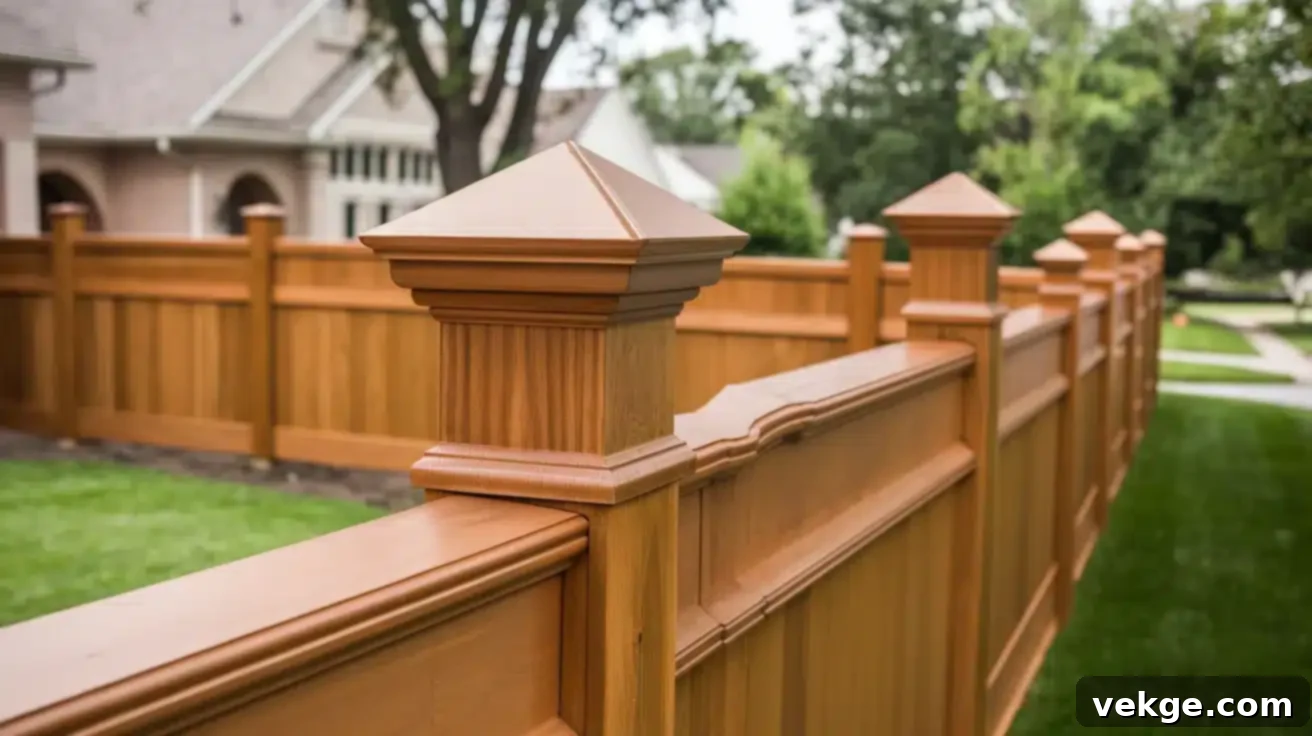
Cap and trim fences offer far more than just privacy for your yard. Their unique design delivers a range of advantages that make them a preferred choice for discerning homeowners looking for lasting value and beauty. Here’s why so many homeowners are choosing this elegant and robust fence style:
1. Enhanced Aesthetic Appeal
A cap and trim fence instantly elevates your home’s exterior, providing a complete, balanced, and sophisticated look that standard fences simply can’t match. The clean lines of the top cap and the structured framing of the trim pieces add a level of architectural detail that makes your property feel more polished and high-end. You have endless possibilities to customize this appeal further by adding special decorative post caps, selecting unique trim patterns, or choosing specific stains and paints that perfectly complement your home’s existing style and landscaping. This design flexibility ensures your fence integrates seamlessly with your overall property aesthetic, boosting its curb appeal dramatically.
2. Superior Durability and Longevity
One of the most significant advantages of cap and trim fences is their enhanced durability. The top cap acts as a crucial protective barrier, preventing rain and moisture from directly soaking into the vulnerable end-grain of the fence pickets and posts. This proactive protection is vital in blocking the onset of rot and decay, which commonly starts from the top down in standard fences. Similarly, bottom trim pieces often serve as a “kick board” or “gravel board,” helping to lift the main fence panels slightly off the ground. This separation prevents direct contact with ground moisture, soil, and debris, which are major contributors to rot, insect damage, and premature deterioration. By mitigating these common issues, a cap and trim fence can last many years longer than conventional fence types, offering a better return on your investment.
3. Increased Stability and Structural Integrity
The added cap and trim components contribute significantly to the overall stability and structural integrity of the fence. By essentially creating a “boxed” or “framed” structure around the fence panels, these elements reinforce the entire assembly. This reinforcement makes cap and trim fences incredibly strong and resilient against adverse weather conditions, including high winds and heavy storms. The cap ties the fence posts and pickets together at the top, while the trim provides additional bracing along the panels. Adding an optional middle rail further enhances this stability, helping to keep all components straight and firmly in place, especially in regions prone to strong gusts or fluctuating temperatures.
4. Extensive Customization Options
Cap and trim fences offer unparalleled customization, allowing you to create a truly unique look that reflects your personal style and complements your home’s architecture. You can choose from a wide variety of wood species like cedar, redwood, or pressure-treated pine, each offering distinct grain patterns and natural hues. Beyond the wood itself, the cap and trim components open up a world of design possibilities. Select different cap profiles (flat, pyramid, Gothic), trim widths, and decorative elements. Further customize with an array of stains, paints, or sealants to achieve the perfect finish, whether you prefer a natural wood look, a modern painted finish, or a rustic weathered appearance. This flexibility ensures your fence will be a one-of-a-kind statement piece.
5. Significantly Increased Property Value
A well-maintained, aesthetically pleasing, and long-lasting fence is a significant asset that substantially adds to your home’s market value. Cap and trim fences, with their superior durability, enhanced curb appeal, and customizability, are particularly effective in boosting property value. Potential buyers instantly recognize the quality and attention to detail that such a fence represents. It signals a well-cared-for home with high-quality outdoor features, making your property more attractive and often commanding a higher selling price. Investing in a cap and trim fence is not just about enhancing your living space; it’s a smart financial decision for the future of your home.
Types of Cap and Trim Fences
When selecting a cap and trim fence, the material choice is paramount, as it dictates the fence’s appearance, durability, and maintenance requirements. Each material offers distinct advantages tailored to different needs and budgets. Let’s explore the most popular options available for your project.
1. Wooden Cap and Trim Fence
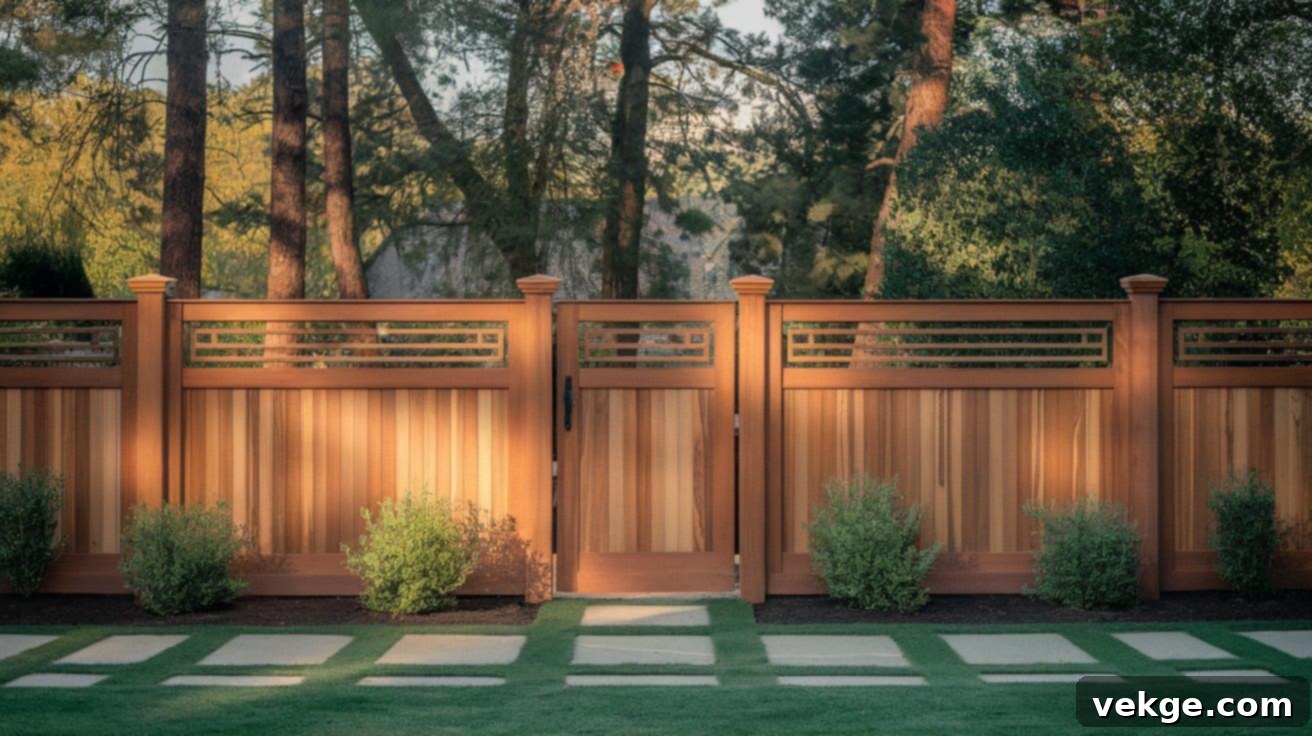
Wooden cap and trim fences remain a timeless and popular choice, celebrated for their natural beauty and versatility. Top picks for wood include cedar, redwood, and pressure-treated pine. Cedar is renowned for its natural resistance to rot and insects, its beautiful reddish hue, and its pleasant aroma. Redwood offers similar decay resistance and a rich, deep color. Pressure-treated pine, while not as naturally resistant, is chemically treated to withstand rot, fungi, and insects, making it a cost-effective and durable option, especially for ground contact.
These woods bring a warm, organic feel to your yard that is truly unmatched. You have the flexibility to stain or paint them to perfectly match your home’s exterior or existing color palette, allowing for complete design cohesion. Alternatively, many homeowners choose to let the wood weather naturally over time, developing a beautiful silver-grey patina that adds rustic charm. While wooden fences do require some regular care—such as cleaning, sealing, and occasional repairs—many homeowners find that the classic, inviting look and feel of natural wood are well worth the effort, creating a truly inviting outdoor space.
2. Vinyl Cap and Trim Fence

For homeowners who prioritize minimal maintenance and maximum durability, a vinyl cap and trim fence is an excellent solution. If you dislike the thought of outdoor upkeep like painting or staining, vinyl could truly be your best friend. These fences are available in a variety of colors, most commonly white, tan, or grey, and are engineered to be fade-resistant, meaning they will never need painting or staining. They retain their vibrant color and pristine appearance for decades with little effort.
Vinyl fences are impervious to rot, insects, and warping, offering exceptional longevity. When it rains or snows, simply let nature wash your vinyl fence clean; for tougher dirt, a quick rinse with a garden hose is usually sufficient. This eliminates the need for tedious weekend scrubbing, sanding, and staining, saving you valuable time and money over the years. While the initial investment for a vinyl fence might be slightly higher than some wooden options, the long-term savings on maintenance and replacement costs, combined with their enduring beauty, make them a highly cost-effective choice.
3. Pressure-Treated Cap and Trim Fence
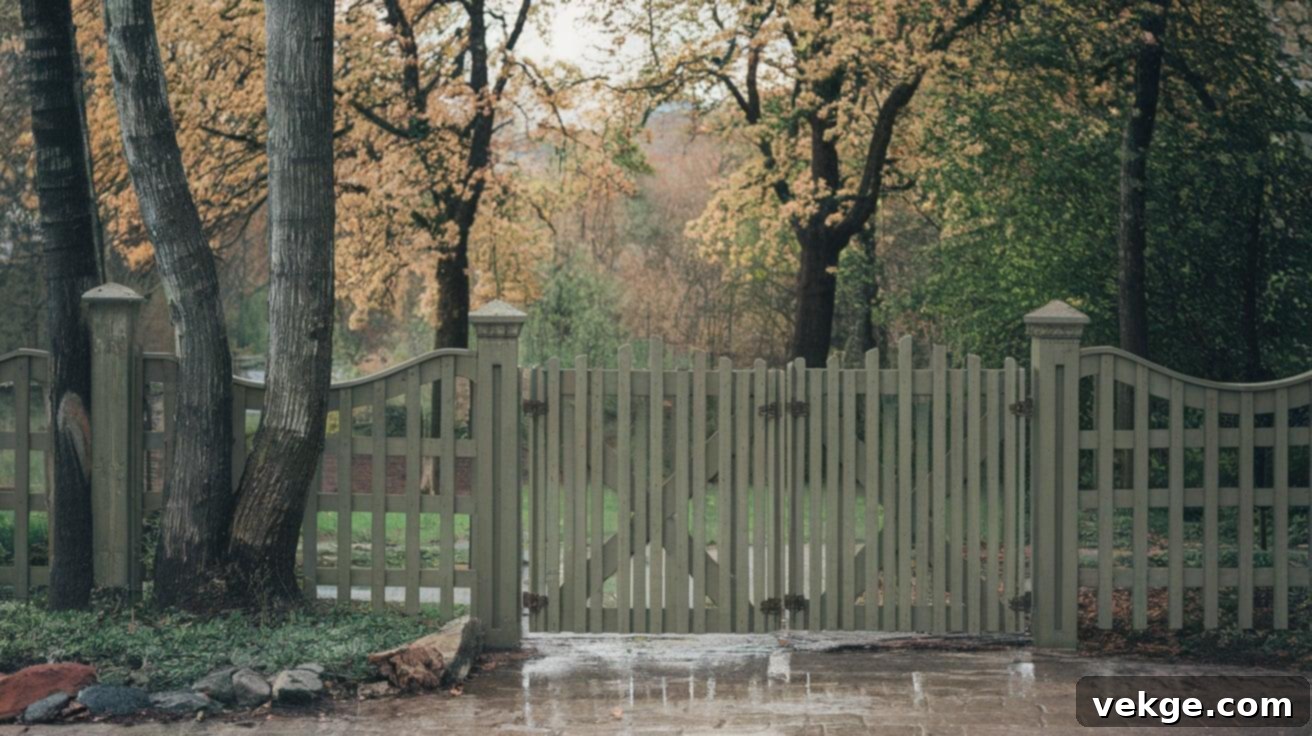
Pressure-treated wood is a specific type of wooden material that undergoes a chemical treatment process to make it highly resistant to decay, rot, and insect infestation. This makes it an especially robust choice for cap and trim fences, particularly in challenging environments. For wet climates, areas with high humidity, or locations near swimming pools where moisture is a constant factor, pressure-treated wood stands up to these conditions significantly better than untreated wood. The special chemical treatment penetrates the wood fibers, creating a barrier that deters pests and prevents fungal growth, ensuring your fence remains structurally sound and visually appealing for a longer period.
A smart enhancement for pressure-treated fences is the inclusion of gravel boards or kick boards at the very bottom. These boards elevate the main fence panels slightly off the ground, creating a crucial buffer zone. This added protection is invaluable in areas where moisture often collects or where the fence comes into direct contact with soil, preventing common problems like ground-level rot and insect damage, which typically start from the base of the fence. Pressure-treated cap and trim fences offer a durable, cost-effective solution that provides excellent protection and a classic wood aesthetic, ensuring long-term performance even in demanding conditions.
Cap and Trim Fence Styles
The style of your cap and trim fence plays a pivotal role in defining your home’s personality and the overall ambiance of your outdoor space. Beyond material choice, the design of the cap and trim components allows for incredible customization, enabling you to create a unique aesthetic. Here are some of the most popular and appealing styles to consider when planning your fence project.
Flat Cap and Trim
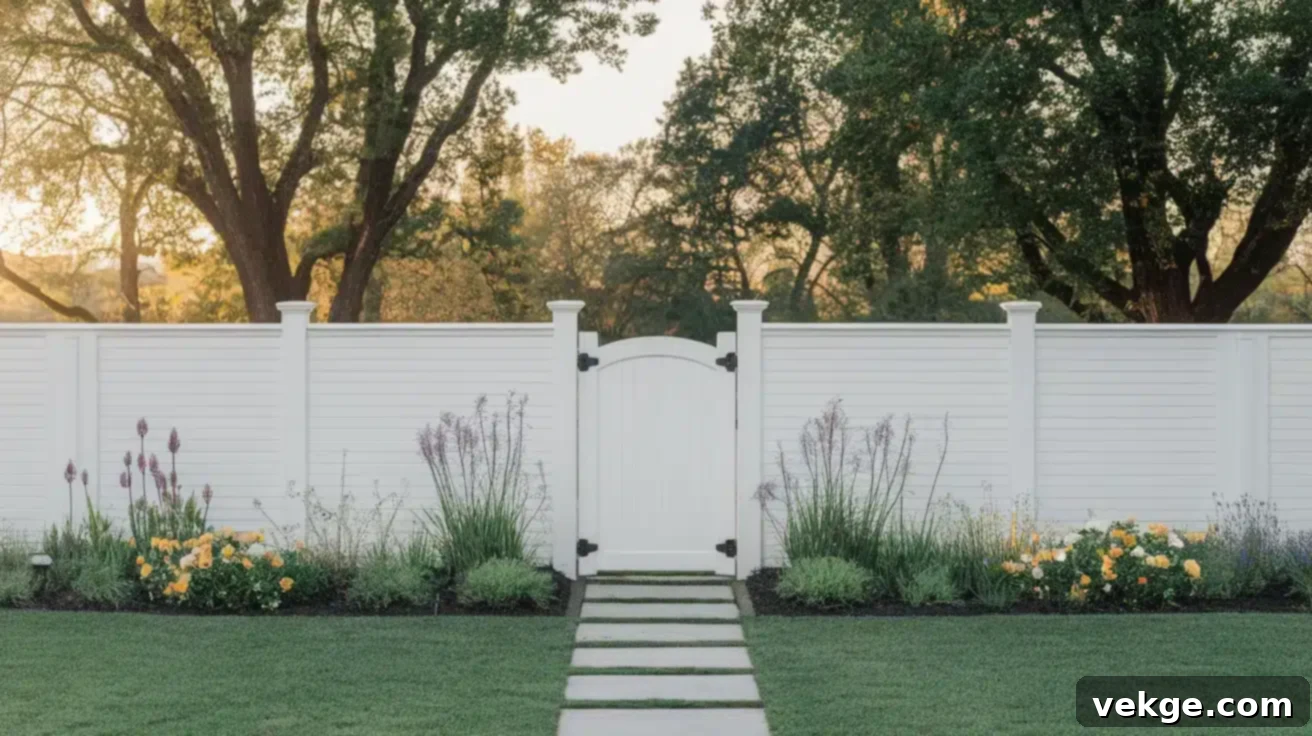
The flat cap style offers a clean, contemporary, and incredibly neat look that seamlessly integrates with a wide variety of home architectural styles, from modern to traditional. This style is characterized by a straight, level top cap that runs uniformly along the entire fence line. It creates crisp, architectural lines that do not distract from your carefully curated landscaping or the existing design elements of your home. A flat cap and trim fence exudes understated elegance and sophistication, providing a polished and finished appearance that is both timeless and effortlessly stylish. It’s an ideal choice for those who appreciate simplicity and a streamlined aesthetic.
Lattice Cap and Trim
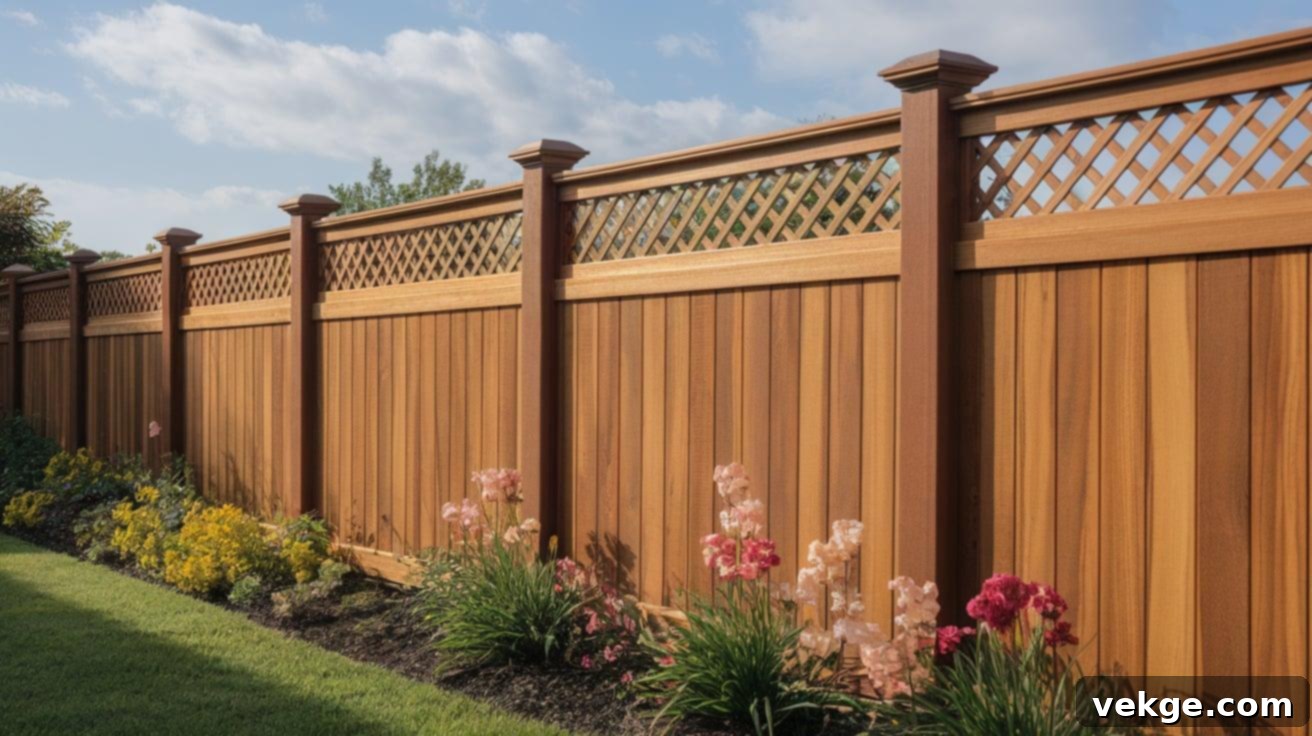
Incorporating a lattice panel into the top section of your fence adds a delightful touch of charm and decorative appeal. This style creates a semi-private barrier that allows a gentle filtering of light and refreshing breezes to pass through, preventing the feeling of being completely walled off. It strikes a beautiful balance between providing privacy and maintaining an open, airy feel, making it a friendly middle ground that many homeowners adore. Lattice sections are also wonderfully versatile for incorporating climbing plants or vines, allowing you to introduce greenery and further soften the fence’s appearance, turning it into a living wall that changes with the seasons.
Scalloped Cap and Trim
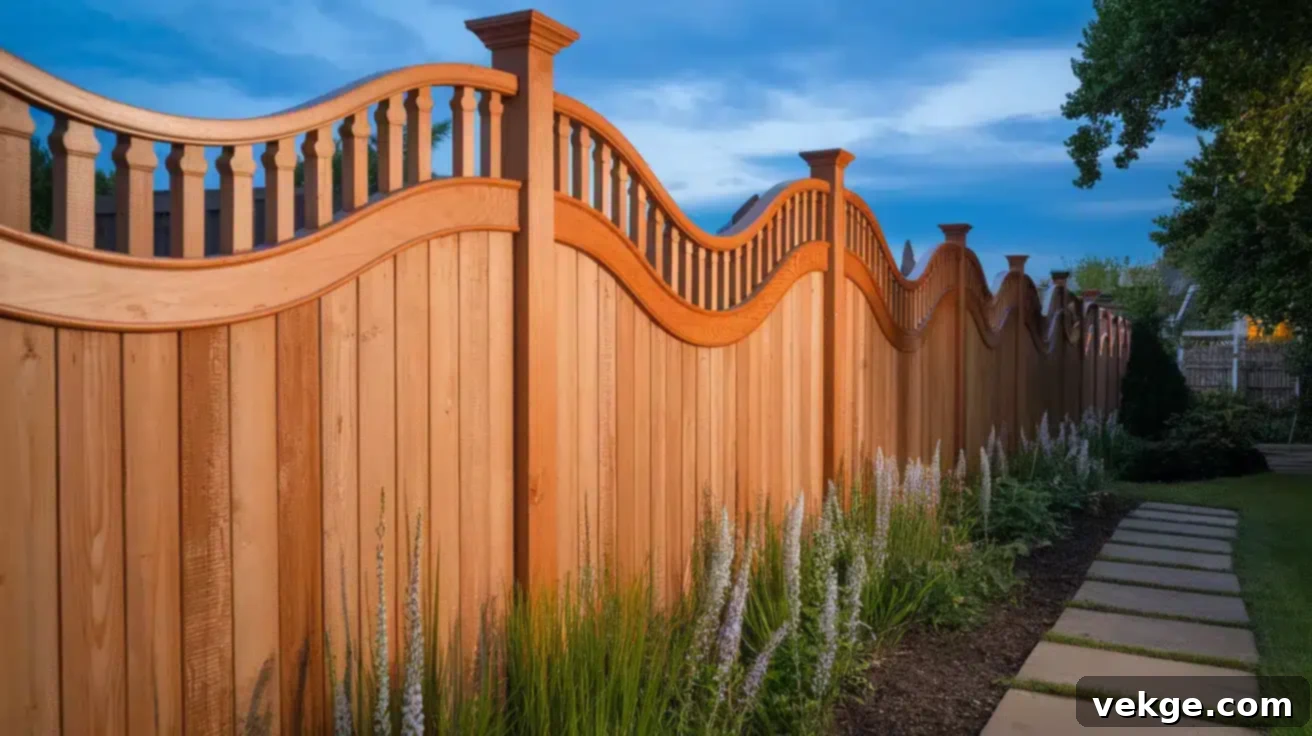
For those seeking to infuse their yard with a softer, more whimsical aesthetic, the scalloped fence top is an ideal choice. This distinctive style features gentle, elegant curves where each fence section dips gracefully in the middle, creating a continuous wave pattern along the top of the fence. This flowing design introduces a sense of playfulness and fluidity, offering a refreshing departure from the rigidity of straight edges. A scalloped cap and trim fence adds a touch of classic charm and an inviting, approachable feel to your outdoor space, perfect for creating a picturesque garden setting or a relaxed family backyard.
Gothic and French Gothic Styles
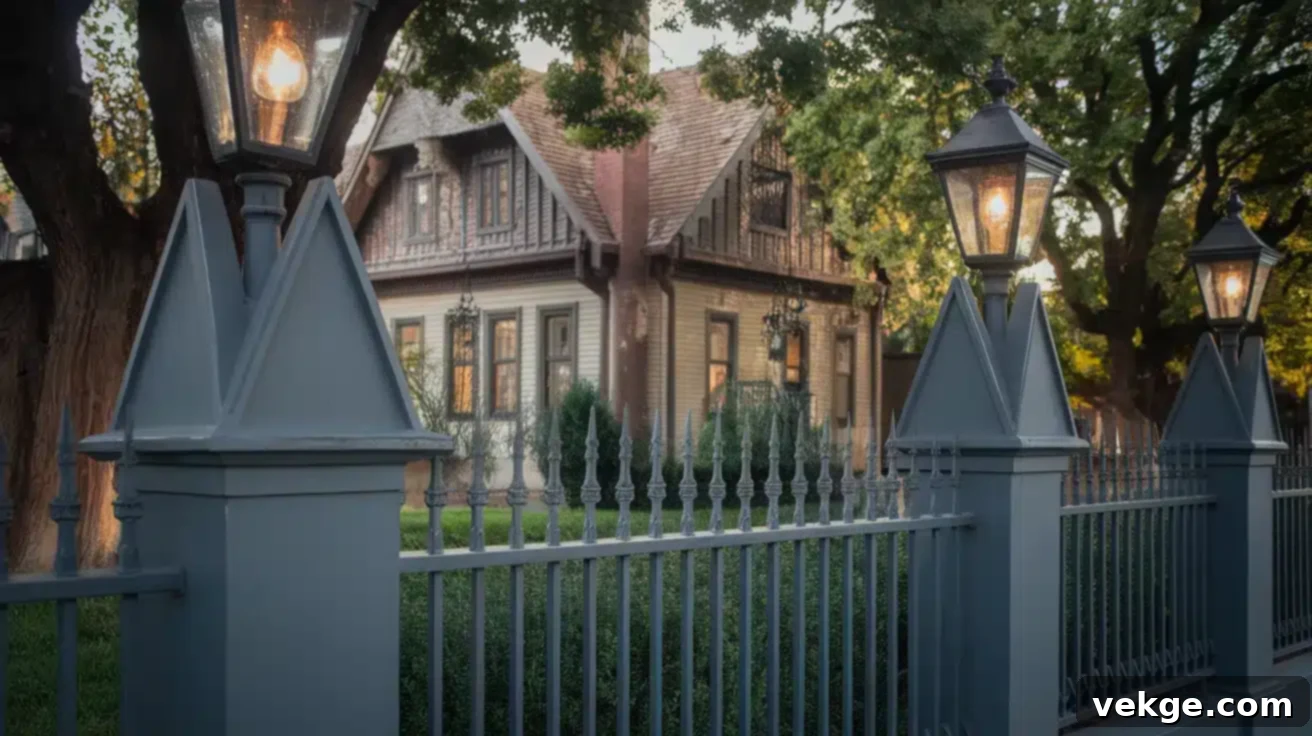
Drawing inspiration from historic European architecture, Gothic and French Gothic styles bring a distinctive sense of elegance and sophistication to your fence. These designs are characterized by pointed tops or finials that adorn each post or picket, reminiscent of classic garden fences found in grand estates. The sharp, decorative peaks add an undeniable touch of class and architectural interest, making your fence a prominent feature that truly stands out in your neighborhood. Perfect for homes with a traditional or stately aesthetic, these styles evoke a sense of heritage and refined beauty, elevating your property’s grandeur.
Pyramid Cap and Trim
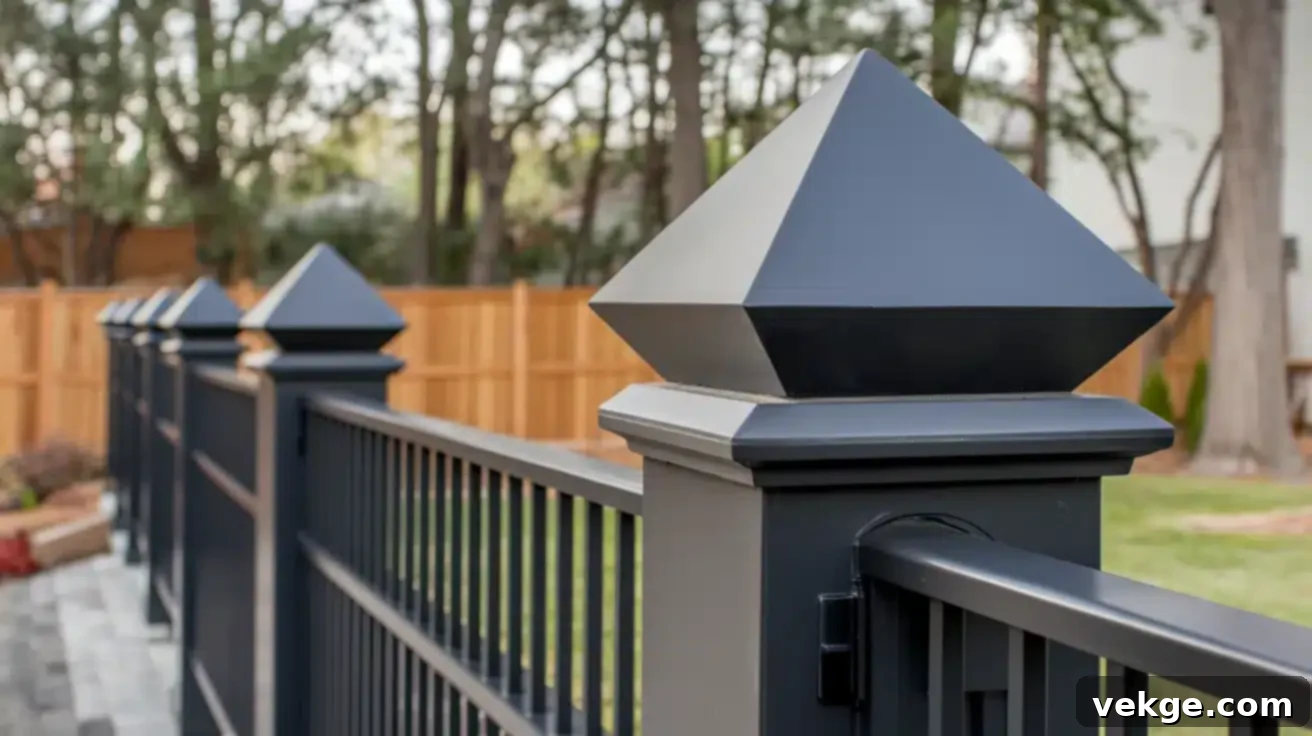
Pyramid caps are a popular choice for post toppers, adding a stately and substantial finished look to each fence post. With their distinctive four-sided peaks, these caps create a strong visual statement that enhances the architectural quality of your fence. They are designed to sit atop each post, providing both a decorative flourish and crucial protection for the post’s end-grain from weather exposure. Pyramid caps catch the light in interesting ways throughout the day, adding depth and dimension to your fence line. They impart a sense of permanence and classic solidity, giving your fence a more formal and impressive presence.
Cap and Trim Fence vs. Other Fence Types
To truly appreciate the value of a cap and trim fence, it’s helpful to compare it with other common fence types. This comparison highlights its unique advantages in terms of aesthetics, durability, and long-term cost-effectiveness.
|
Feature |
Cap and Trim Fence |
Dog Ear Fence |
Stockade Fence |
Board-on-Board Fence |
|
Appearance |
Offers a highly clean, polished, and finished look with a distinct top cap and decorative side trim. Presents a symmetrical, framed aesthetic. |
Features pickets with rounded-off top corners, creating a softer, more casual look. Simpler aesthetic compared to cap and trim. |
A very simple, basic design characterized by closely spaced pickets with pointed tops. Provides utility over decorative appeal. |
Features overlapping boards (typically on one side) creating a deep, textured look with no gaps, ensuring maximum privacy. |
|
Cost |
Higher initial cost due to the additional materials (cap boards, trim pieces) and labor required for their installation. |
Generally a more budget-friendly option, as it uses standard pickets with minimal extra finishing. |
Often the most affordable option for privacy, as it uses basic materials and a straightforward installation process. |
Mid-range cost, slightly higher than dog ear due to the increased material (overlapping boards) but less than cap and trim. |
|
Durability |
Exceptional durability. The top cap crucially protects the vulnerable end-grain of wood from water damage, significantly preventing rot and extending lifespan. |
Rounded tops help shed some water, but offer less comprehensive protection against moisture ingress and subsequent rot compared to a full cap. |
Basic design with minimal inherent weather protection; exposed picket tops are susceptible to rot and sun damage. |
Good durability; the overlapping design helps with wind resistance and provides slightly more protection than basic picket fences. |
|
Maintenance |
Requires less frequent maintenance at the top due to the protective cap, leading to a longer lifespan of the wood components. |
Needs more frequent sealing and inspection, especially at the tops of the pickets, to prevent premature weathering and rot. |
Requires regular and diligent maintenance, including sealing and checking for rot, to prevent rapid deterioration. |
Needs standard maintenance (sealing/staining). The overlapping boards tend to warp less than single pickets, reducing repair frequency. |
|
Privacy |
Provides complete privacy with a highly finished and attractive look on both sides, enhancing the view for both owner and neighbor. |
Offers good privacy, but small gaps may appear between pickets as the wood seasons and shrinks over time. |
Provides basic privacy initially, but gaps can develop quickly over time as the wood dries, making it less robust for long-term privacy. |
Offers the best privacy due to the intentionally overlapping boards, ensuring virtually no visibility through the fence, even as wood shrinks. |
|
Lifespan |
Typically 15-20+ years with proper installation and consistent care, thanks to superior weather protection. |
Generally 10-15 years with standard maintenance. |
Often 8-12 years, requiring more frequent repairs or replacement. |
Approximately 12-18 years, offering good longevity due to robust construction. |
|
Wind Resistance |
Features a strong and reinforced structure, with the cap providing additional rigidity, making it highly resistant to strong winds. |
Standard wind resistance; individual pickets may be prone to warping or loosening in very high wind conditions. |
Less stable in strong winds; can be more susceptible to damage or leaning in adverse weather. |
Excellent wind resistance due to the overlapping and often staggered board design, which distributes wind pressure more effectively. |
|
Best For |
Homeowners seeking a premium, long-term investment, desiring superior curb appeal, maximum durability, and a highly polished finish. |
Budget-conscious homeowners looking for a simple, functional privacy fence with a slightly softened aesthetic. |
Those needing basic privacy on a very tight budget, where longevity and aesthetics are secondary concerns. |
Areas experiencing high winds or where maximum, gap-free privacy is the absolute top priority. |
DIY Guide: How to Build a Cap and Trim Fence
Building your own cap and trim fence can be a highly rewarding project, offering significant cost savings and the satisfaction of a job well done. While it requires careful planning and attention to detail, a DIY approach is achievable for many homeowners. Here’s a detailed guide to help you construct a beautiful and durable fence.
Materials and Tools Needed
- Fence Posts: Typically 4×4 or 6×6 pressure-treated lumber, long enough to be buried one-third of their height.
- Pickets: The main vertical boards forming the fence panel (e.g., 1×6 or 1×8 cedar, redwood, or pressure-treated).
- Rails: Horizontal boards (e.g., 2×4) that connect posts and to which pickets are attached.
- Cap Boards: Wider boards (e.g., 2×6 or 2×8) for the very top of the fence.
- Trim Pieces: Narrower boards (e.g., 1×2 or 1×4) for the top and bottom edges of the fence panels.
- Concrete Mix: For securely setting posts.
- Fasteners: Galvanized screws (2.5-3 inches for pickets/rails, 3-4 inches for caps/trim) or ring-shank nails.
- Post Hole Digger: Manual or power auger.
- Tape Measure and String Line: For accurate layout and alignment.
- Level: A long level (4ft or 6ft) for posts, and a smaller level for pickets.
- Circular Saw or Miter Saw: For precise cuts.
- Cordless Drill/Driver: With appropriate bits.
- Safety Gear: Gloves, safety glasses, ear protection.
- Shovel and Wheelbarrow: For mixing concrete.
Step 1: Measuring and Planning
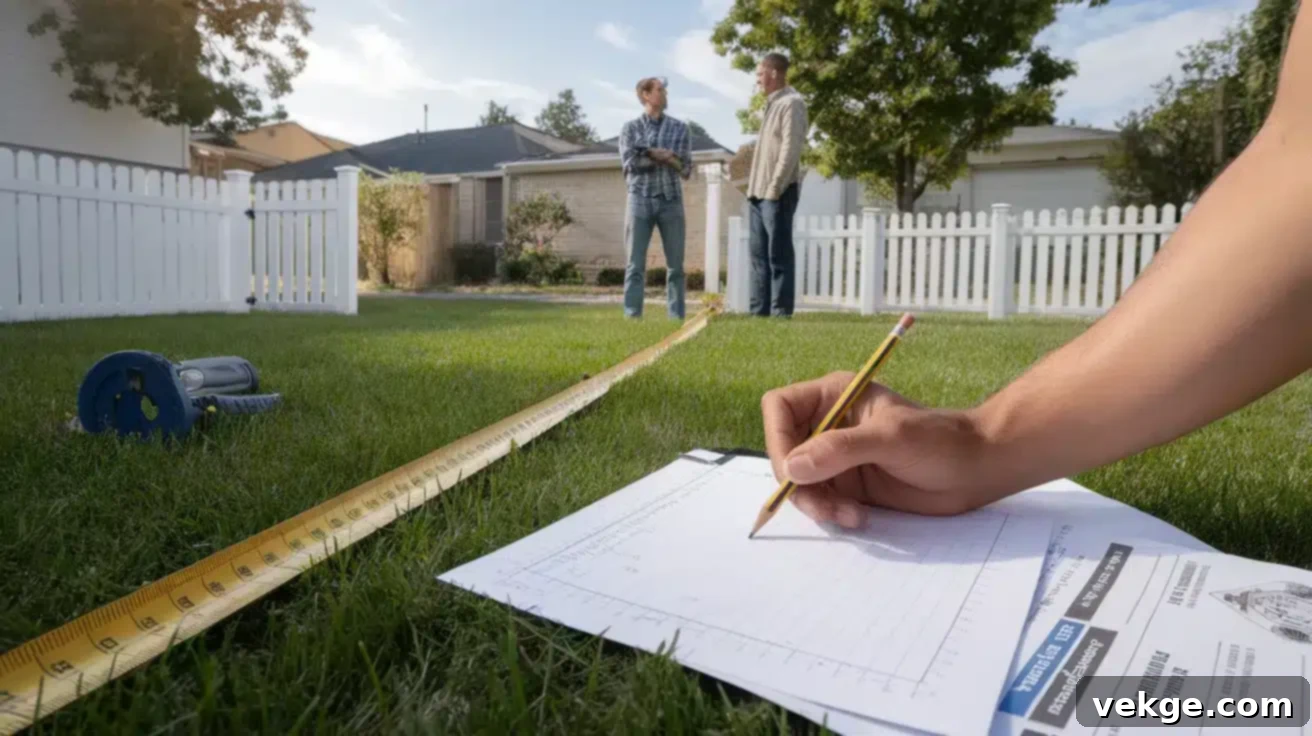
Accurate planning is the foundation of a successful fence project. Begin by sketching your fence layout, clearly marking property lines and any gates. This is a critical step to avoid disputes and ensure compliance. Before digging, always check with your local city or county building department about required permits, setbacks, and local fence codes and ordinances. Additionally, call 811 (the national “Call Before You Dig” hotline) a few days in advance to have underground utility lines marked on your property. It’s also good practice and common courtesy to discuss your fence plans with your neighbors, especially if the fence will be on a shared property line.
Step 2: Setting Posts
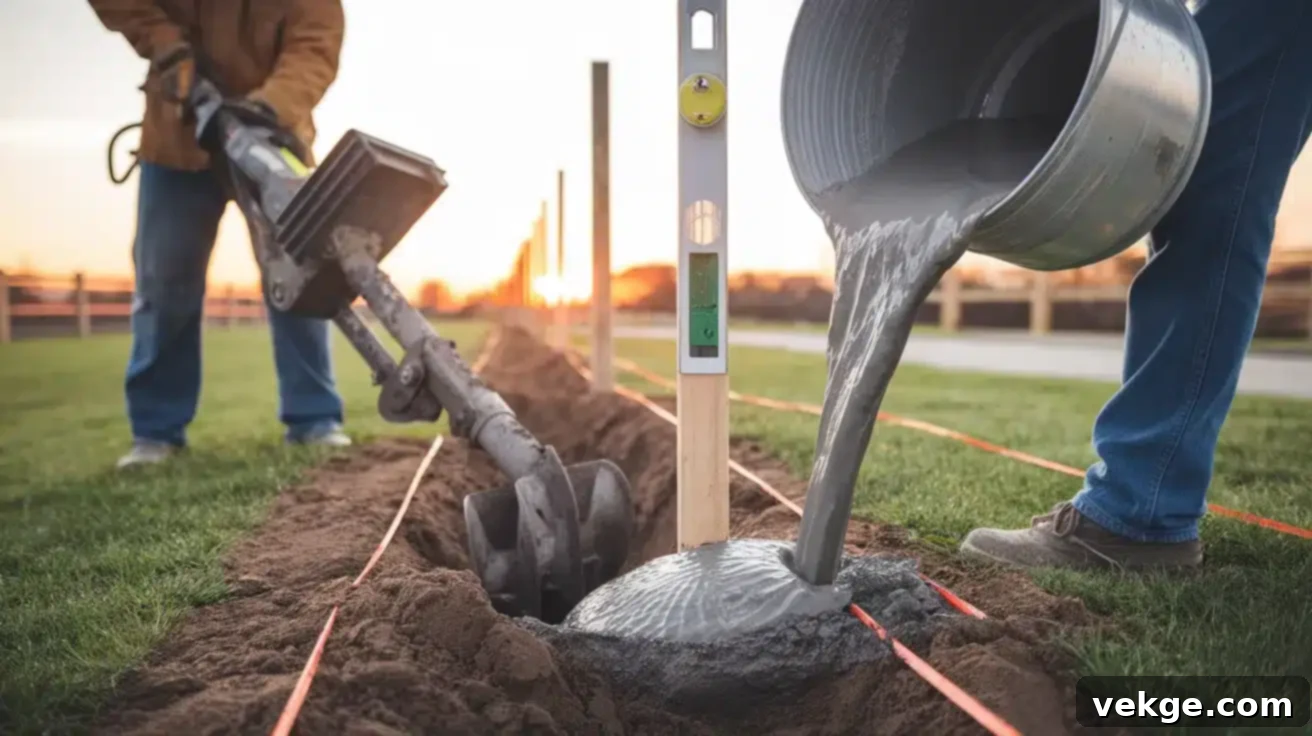
Mark the precise locations for your fence posts according to your plan, typically 6 to 8 feet apart. Dig post holes that are at least 1/3 the height of your post deep (e.g., for a 6-foot-tall fence, a 9-foot post buried 3 feet deep) and three times the width of the post. Place a few inches of gravel at the bottom of each hole for drainage. Insert the post, ensuring it’s perfectly plumb (straight up and down) using a level. Mix concrete according to the manufacturer’s instructions and pour it around the post, making sure to crown the top of the concrete slightly to shed water away from the post. Re-check for plumb and brace the posts if necessary. Allow the concrete to cure completely, ideally overnight or for 24-48 hours, before proceeding to the next steps.
Step 3: Installing Rails and Pickets

Once your posts are securely set, attach the horizontal rails between them. For a typical privacy fence, you’ll need at least two rails (top and bottom); a third middle rail can add significant stability. Ensure the rails are perfectly level across the span. Use a string line to maintain a consistent height. Next, attach your pickets vertically to the rails using galvanized screws or ring-shank nails. Use a spacer (e.g., a 1/4-inch piece of scrap wood) to leave consistent small gaps between boards. These gaps are crucial to allow for wood expansion in wet weather and contraction in dry conditions, preventing warping and buckling. Use your level frequently to ensure each picket is plumb.
Step 4: Adding Cap and Trim Boards
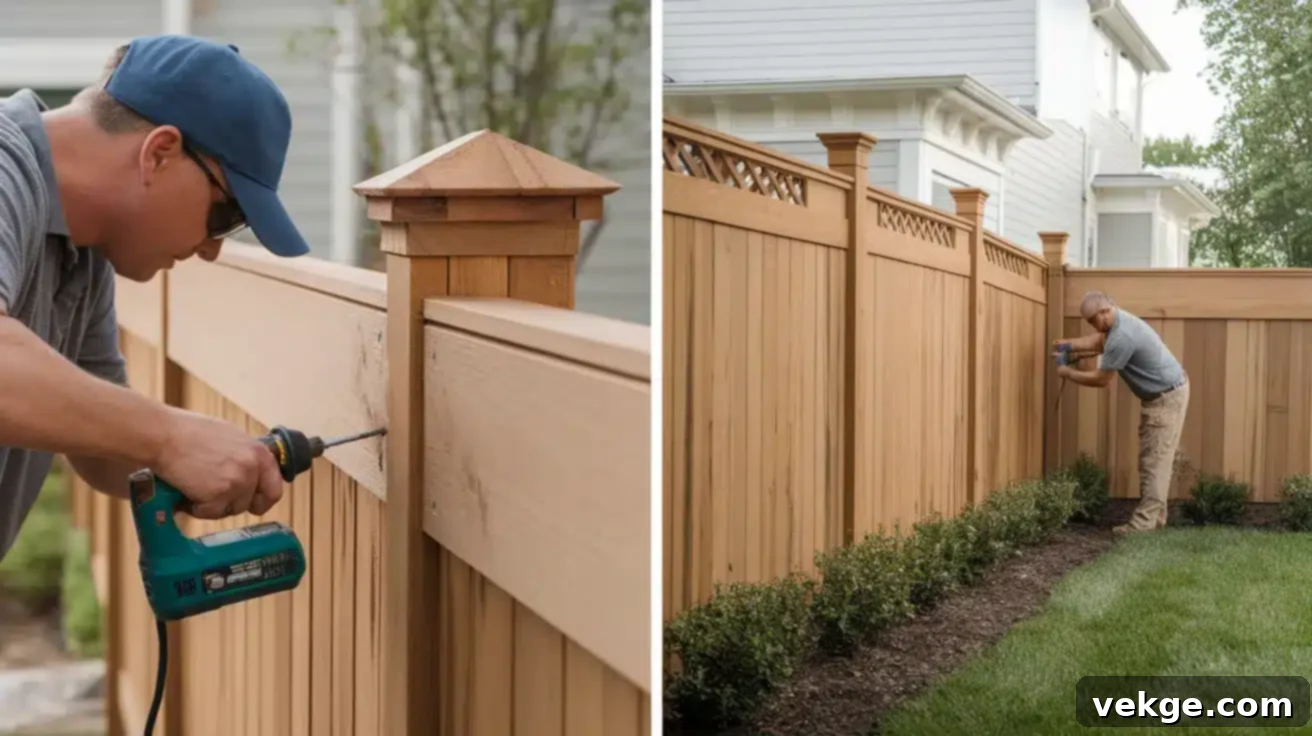
This step is what truly defines a cap and trim fence. First, attach the cap boards to the very top of your fence line, spanning across the posts and pickets. Ensure these boards are level and centered for a clean, continuous look. Use long, galvanized screws driven down into the posts and pickets to secure them firmly. Next, add the trim pieces. These typically run along the top and bottom horizontal edges of the fence panels, framing the pickets. The bottom trim often doubles as a kick board, protecting the pickets from ground moisture. The cap and trim components not only complete the aesthetic but also provide essential weather protection, directing water away from vulnerable areas and significantly boosting the fence’s durability.
Step 5: Sealing and Finishing
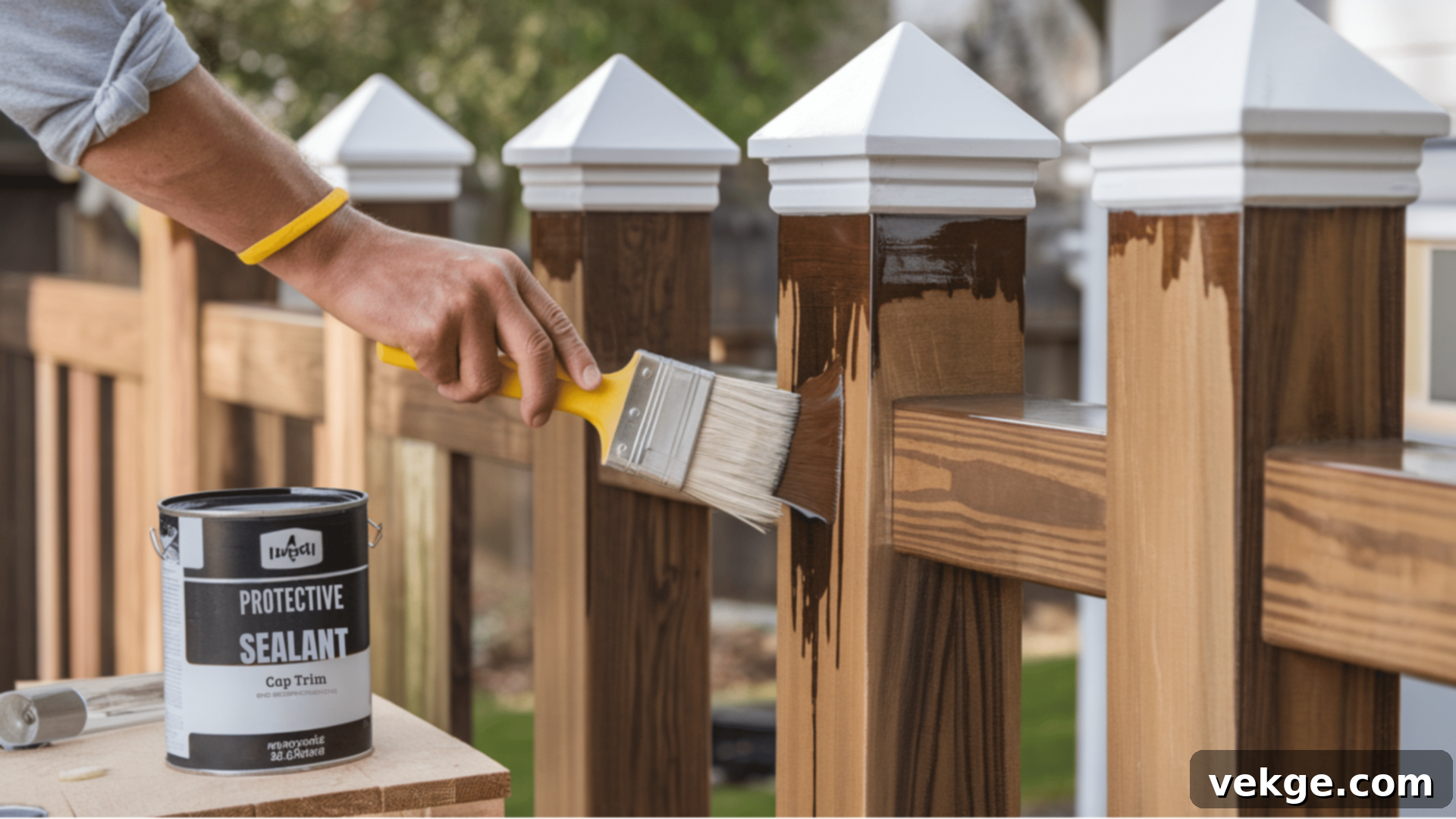
The final, crucial step is to protect your newly built fence with a high-quality wood sealer or stain. This protective layer is vital for safeguarding your hard work against the damaging effects of rain, UV radiation from the sun, and wood-boring insects. Choose a product that suits your desired aesthetic – whether a clear sealant to highlight the natural wood grain, a semi-transparent stain for subtle color, or a solid stain for opaque coverage. Apply it evenly with a brush, roller, or sprayer, ensuring all surfaces, especially the end-grain of the cap and trim pieces, are well-covered. Proper sealing will not only enhance the fence’s beauty but also dramatically extend its lifespan, ensuring it stands tall and strong for many years to come.
Maintenance and Longevity Tips for Cap and Trim Fences
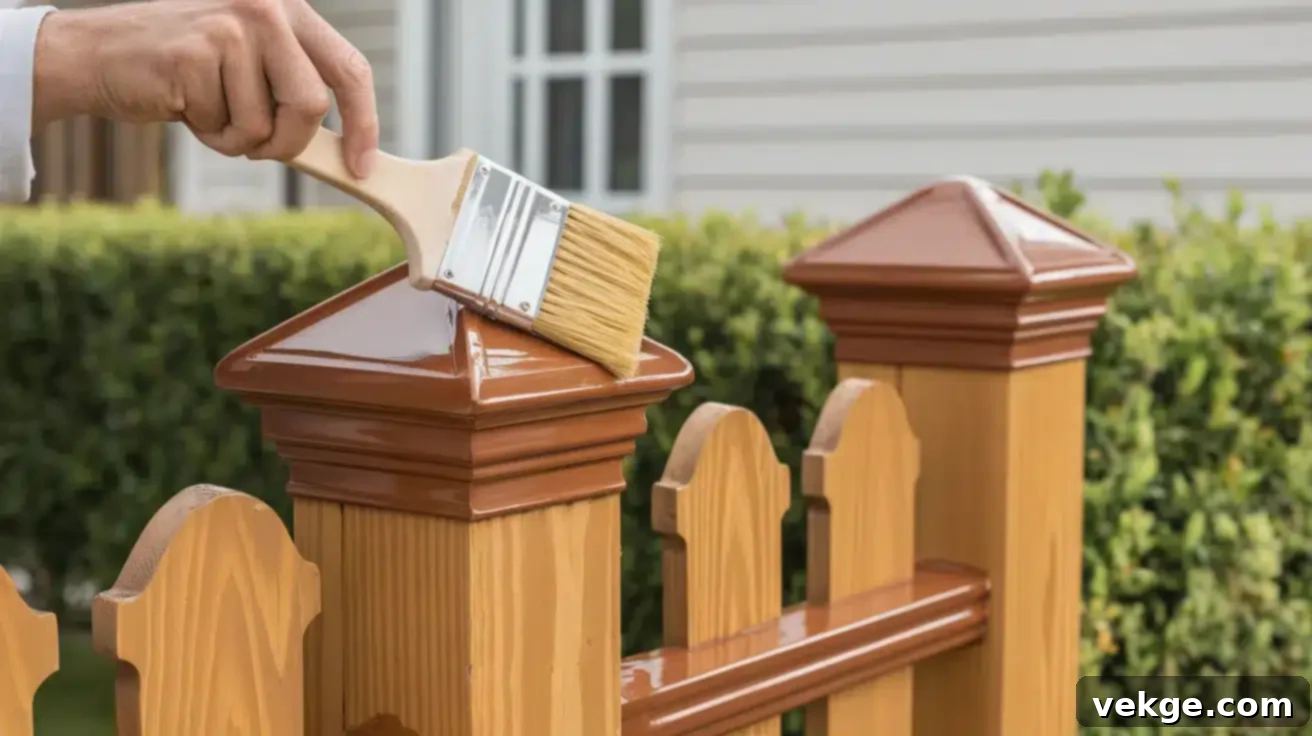
While cap and trim fences are designed for superior durability, a proactive approach to maintenance is key to maximizing their lifespan and keeping them looking their best. A little consistent attention can prevent major issues and preserve your investment for decades.
Preventing Damage: Regular Inspections and Cleaning
- Inspect Twice Yearly: Make it a habit to thoroughly inspect your fence at least twice a year, ideally in spring and fall. Look for any signs of wear and tear, such as loose pickets, damaged cap or trim pieces, popped nails or screws, cracks, splintering wood, or signs of rot or insect activity.
- Address Issues Promptly: Fix any loose boards, tighten fasteners, or replace damaged sections immediately. Proactive repairs prevent minor issues from escalating into costly problems.
- Keep it Clean: Regularly clean off dirt, grime, mildew, and moss with a soft brush and a mild soap solution (e.g., diluted dish soap). For tougher stains, a gentle power wash on a low setting can be effective, but avoid high pressure which can damage wood fibers.
- Manage Vegetation: Trim back any shrubs, trees, or vines that are growing too close to or directly on the fence. Vegetation can trap moisture against the wood, promoting rot and mildew growth. Ensure good air circulation around the fence.
Best Stains and Sealants for Protection
- Choose Wisely: Selecting the right protective finish is crucial.
- Oil-based stains/sealants penetrate deeper into the wood, offering excellent moisture resistance and often providing a richer, more durable color. They are ideal for deeper wood protection.
- Water-based sealants are easier to clean up and dry faster, making them a convenient option. They offer good surface protection and are often more environmentally friendly.
- Clear sealants allow the natural beauty of the wood to shine through while offering UV and moisture protection.
- Semi-transparent stains add a hint of color while still allowing the wood grain to be visible.
- Solid stains provide opaque color coverage, similar to paint, but still protect and penetrate the wood.
- Regular Reapplication: For best results, plan to apply a fresh coat of stain or sealant every 2-3 years, depending on the product, local climate, and sun exposure. Always follow the manufacturer’s recommendations.
Seasonal Maintenance Checklist
Spring
- Post-Winter Check: After the cold and wet winter months, thoroughly inspect your fence for any damage caused by freezing temperatures, thawing cycles, or heavy snow loads.
- Gentle Wash: Wash off accumulated dirt, salt, and mildew with a gentle pressure wash or a scrub brush and mild cleaner.
- Minor Repairs: Fix any boards that may have shifted, tightened loose fasteners, or addressed any minor cracks.
Summer
- Stain/Sealant Application: This is the ideal time to apply fresh stain or sealant, as it requires a dry, mild day for proper application and curing. Ensure the wood is clean and completely dry before applying.
- Vegetation Management: Keep a close eye on plants and trim back any new growth that touches the fence. Direct sprinklers away from the fence to prevent unnecessary moisture exposure.
Fall
- Debris Removal: Clear fallen leaves, branches, and other debris from the base of the fence. Allowing organic matter to pile up against the wood can trap moisture and accelerate rot.
- Drainage Check: Ensure that the ground near the fence slopes away from the posts, allowing water to drain effectively and preventing pooling, which can lead to moisture damage.
Winter
- Snow Removal: If you experience heavy snowfall, gently remove excessive snow buildup from the top cap of the fence to prevent undue stress and prolonged moisture contact.
- Prevent Ice Damage: Keep sprinklers aimed away from the fence, especially during freezing weather, to prevent ice accumulation on the wood, which can cause splintering or structural stress.
Conclusion
Throughout this comprehensive guide, we’ve explored every facet of cap and trim fences, from their fundamental design to their profound impact on your property. We’ve delved into what makes them unique, examined the diverse range of styles and materials available, provided a practical DIY installation guide, and shared essential maintenance tips for lasting beauty and performance. You now possess the in-depth knowledge to make astute and confident choices for your home’s fencing needs.
While cap and trim fences may represent a slightly higher initial investment compared to more basic options, their long-term benefits far outweigh the upfront cost. These fences truly pay you back over time by enduring longer, maintaining their aesthetic appeal year after year, and significantly enhancing your property’s value and curb appeal. The added durability and refined finish ensure that your fence remains a source of pride and protection for decades.
The right fence is more than just a boundary; it’s a statement piece that frames your outdoor space, defines your personal sanctuary, and contributes to the overall character of your home. Choosing a cap and trim fence allows you to select a style that not only meets your practical needs but also genuinely makes you smile every time you arrive home. With the detailed maintenance strategies we’ve outlined, your cap and trim fence will stand as a beautiful, resilient testament to quality craftsmanship through countless seasons of family gatherings, joyful moments, and tranquil evenings in your perfectly framed backyard.
